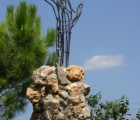Salvador Sala Esquius
Extant
Serinyà, Catalonia, 17852, Spain
Few of the constructions are visible from the street, but if the artist is at home, he is generally amenable to showing visitors around the site.
About the Artist/Site
Salvador Sala, his brother and two sisters were born in Manresa; their father was a farmer and their mother worked in one of the textile factories for which that city is famous. She was also very artistically inclined, and painted as a young woman; she additionally worked with ceramics and other crafts. Salvador attended elementary school in Manresa until the age of fourteen, and then moved to Barcelona. Although he spent one year as a waiter on the Costa Brava, most of his early work was as a carpenter. As he increased his skills, he opened a carpentry workshop around 1978, and soon began teaching classes as well. He had had no formal art training but, having been influenced by his mother, he began to paint and draw a bit during this time. Although he occasionally displayed his work in small non-professional venues such as bars, however, he had little success selling his work. He worked with a friend designing furniture on commission and did contract carpentry work in houses; he also made small wooden crafts, distinguishing his work from that of others by a modicum of experimentation with forms, and selling them in artisanal fairs and markets.
After a three-month trip to South America in 1997, Sala realized that his dealings with the people around him were minimal and insignificant, and he came to believe that he could live anywhere, keeping to himself. The following year he moved to the little village of Serinyà, in the flats of the Pla de l’Estany county near the small city of Banyoles. He found and purchased a house there, on a site of just under an acre; as it was in a state of ruin, it cost him almost nothing. In the village he returned again to his painting—a lifelong interest that he had not concentrated on since those years in the 1970s—but soon came to the conclusion that his works were disappointing and uninteresting, even to himself: he believed that he was a failure.
In 2003 his beloved mother died; she left him a property that he was able to sell, and he used the proceeds to take several years leave of absence from work, doing only what he pleased. This luxury provided him the time to consider his new property. Living alone, Sala thought about being in Serinyà, population just over 1000, as if it were a naufragio [shipwreck]. For him this was a conceptual construct rather than a physical one, and it symbolized not only a certain degree of isolation, but also the stimulation that such an event could provide in terms of taking the physical materials of one’s surroundings and using them to create not only shelter but a sense of place. He began gathering the travertine stones local to the area, as well as others unearthed by his farmer neighbors as they cleared their lands, tossing them to the perimeters, and he immediately found a profound sense of enjoyment as he began to build with them.
Using the organically-shaped limestone forms as his aesthetic and technical foundation, Sala also began foraging for other materials to enhance his constructions; taking advantage of what was around to transform his space, much happier with the casual find than with the acquisition of something for which he had specifically searched. Sala’s use of the travertine stones and other found objects reveal his particular obsession and his personal aesthetic strength. Several towers, some linked with walls or seating areas, stretch some 25-30 feet into the air, ornamented with found objects and traded treasures he received in swaps with friends and local artisans. Perhaps the most impressive work is his Tower of Babel, a symbolic link to the concept of the shipwreck, as in the original biblical account this is where the survivors of the great flood gathered. But it is also symbolic of the importance of communication and the obstacles that prevent easier discourse and interaction between people and peoples. And although the use of trencadís rightly recalls the work of fellow Catalan Antoni Gaudí, the constructions combining broken tiles with found objects and travertine rocks are neither imitations nor facsimiles. They are enabling Salvador Sala to express himself in a new and personal way. Dedicating himself to his work, he says that he is becoming more tolerant of himself. And perhaps as he continues to build, the enhanced interaction stimulated by the colorful towers will not only provide new outlets for communication, but will begin to contravene the negative connotations of the shipwreck, leaving him with the positives that such a trial can engender, including personal, as well as physical, progress and growth.
Few of the constructions are visible from the street, but if the artist is at home, he is generally amenable to showing visitors around the site.
Update: In the four years between my visits, Sala has continued to add to and enhance his backyard environment, as he also continues to work in other media, including marquetry. He has revisited some of his earlier stone columns, adding colorful trencadís tile work, and has added brand new elements as well, many topped with the steel sculptures of an artist friend. He seems much more at peace now, and happy with his work and what he is accomplishing.
~Jo Farb Hernández, 2014
Contributors
Map & Site Information
Serinyà, Catalonia, 17852
es
Latitude/Longitude: 42.1690197 / 2.7431421
Nearby Environments

























Post your comment
Comments
No one has commented on this page yet.